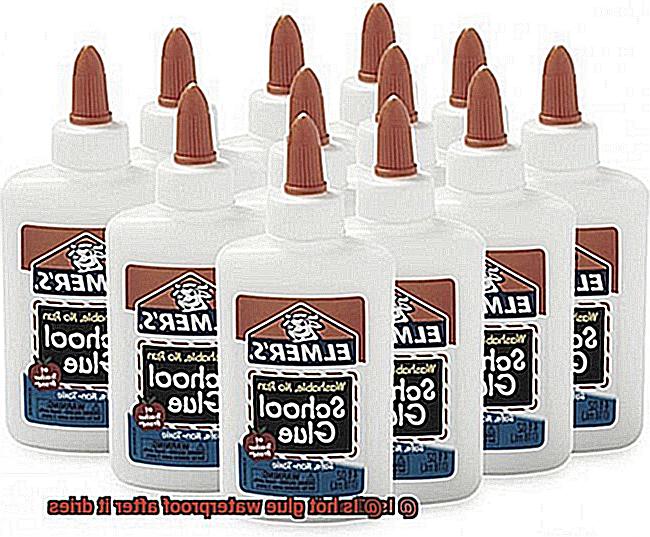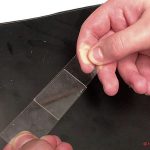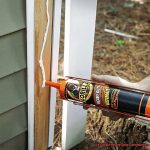Hot glue is a rockstar adhesive that’s famous for its versatility and simplicity. It can stick almost anything together, making it a go-to choice for many DIY projects. But the question on everyone’s lips is whether hot glue is waterproof once it dries. With more people getting into outdoor activities such as hiking, camping, and fishing, this question has become more relevant than ever.
The answer isn’t straightforward because several factors come into play. The type of hot glue used, the surface being glued, and the environment the item will be exposed to all have an impact. However, understanding whether hot glue is waterproof or not is crucial because it affects what projects you can use it for.
In this blog post, we’ll take a deep dive into hot glue and whether it dries waterproof. We’ll explore the science behind hot glue and why it’s such an excellent adhesive. Moreover, we’ll look at different types of hot glue available and which ones are best suited for waterproof applications. Finally, we’ll provide some tips and tricks for achieving a waterproof bond with hot glue and how to use it in outdoor environments.
Whether you’re a DIY enthusiast, crafter or aspiring adventurer – this informative and engaging post will help you make informed decisions about using hot glue in your projects.
What is Hot Glue?
Contents
Hot glue, also known as hot melt adhesive, is a game-changing thermoplastic adhesive that has revolutionized the crafting and DIY world. This adhesive is applied in a molten state with the help of a glue gun that heats up the glue stick, which then melts and flows out of the nozzle of the gun. Once it cools down and solidifies, it forms a strong bond between different materials such as wood, plastic, fabric, and even metal.
The quick-drying time of hot glue makes it a popular choice for various applications where time is of the essence. Hot glue comes in different colors and sizes, and some can even be used for high-temperature applications. Its versatility and ease of use make it a favorite among crafters and DIY enthusiasts worldwide.
Hot glue can be used for a vast array of projects such as scrapbooking, woodworking, and even home repairs. It creates a strong bond that can withstand a fair amount of stress, making it a reliable choice for many applications.
When it comes to water resistance, hot glue is not completely waterproof when in its liquid state but can become water-resistant after it dries. The level of water resistance depends on the type of hot glue being used and the surface to which it is being applied. Some hot glues are specifically designed to be waterproof after they dry, while others may not hold up well when exposed to water.
It is crucial to choose the right type of hot glue based on your project’s needs to ensure a reliable and long-lasting bond. Checking the product label or consulting the manufacturer’s instructions can help determine if a specific hot glue is waterproof after it dries.
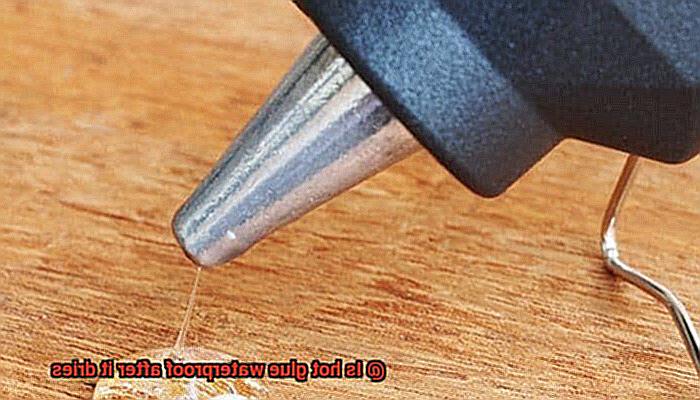
Types of Hot Glue
Hot glue is a versatile adhesive that can be used for a variety of projects. However, not all hot glues are created equal, and it’s essential to understand their different properties and characteristics, including whether they are waterproof after they dry. Let’s take a closer look at the different types of hot glue available in the market.
Standard Hot Glue
This is the most common type of hot glue available on the market. It’s perfect for general-purpose applications and bonds materials like paper, cardboard, wood, and plastic. Unfortunately, standard hot glue is not waterproof after it dries. This makes it unsuitable for projects that require water resistance.
High-Temperature Hot Glue
This type of hot glue has a higher melting point than standard hot glue. It offers a stronger bond and is perfect for materials that require a more durable hold, such as metal, glass, and ceramics. However, like standard hot glue, high-temperature hot glue is not waterproof after it dries.
Low-Temperature Hot Glue
This type of hot glue melts at a lower temperature than standard and high-temperature hot glue. It’s ideal for delicate materials such as foam, fabric, and lace. Low-temperature hot glue dries clear and remains flexible when dry. However, like standard and high-temperature hot glue, it’s not waterproof.
Waterproof Hot Glue
This type of hot glue is specially formulated to be water-resistant after it dries. It forms a strong bond that can withstand exposure to moisture and humidity. Waterproof hot glue is great for outdoor projects or items that will come into contact with water, such as aquariums or water bottles.
Specialty Hot Glue
In addition to the above types of hot glue, there are also specialty hot glues available in the market. These include hot glues that are designed specifically for bonding plastic, fabric or metal, and hot glues that are formulated to be heat-resistant.
When choosing a hot glue for your project, it’s important to consider the materials being bonded and the conditions they’ll be exposed to. If the project will be exposed to water or moisture, it’s crucial to choose a hot glue that is waterproof. Some hot glues are labeled as waterproof, while others may require additional sealant or coating to achieve waterproofness.
Water Resistance of Hot Glue
If you’re one of these, chances are you’ve used hot glue before. Hot glue is a popular adhesive known for its strong bonding properties. But what about its water resistance? Is hot glue waterproof after it dries? Well, the answer is not straightforward.
Hot glue is made from thermoplastic materials that melt when heated and solidify when cooled down. Once the glue has cooled down and hardened, it creates a robust bond between the surfaces it is applied to. However, the water resistance of hot glue can vary depending on the type of glue used and the conditions it is exposed to.
Basic hot glue sticks are not waterproof. They tend to break down and lose their adhesive properties when exposed to water or high humidity. On the other hand, some specialty hot glues are designed to be water-resistant or even waterproof. These types of hot glues are typically labeled as such on the packaging.
But before you get too excited about using waterproof hot glue for your next water-related project, there are some things you need to consider. Even if a hot glue is labeled as waterproof, it may not hold up well under extreme conditions. For example, prolonged exposure to water or high temperatures may weaken its bond strength over time.
Therefore, it’s crucial to evaluate the longevity of your project and decide whether hot glue is the best permanent solution for water-related applications. In addition, it’s essential to choose your hot glue wisely based on the materials being bonded and the conditions they’ll be exposed to.
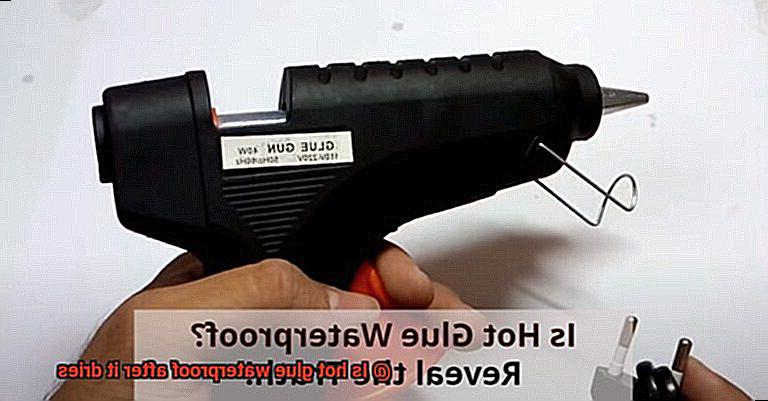
Factors Affecting the Water Resistance of Hot Glue
Hot glue is a versatile adhesive that is widely used in crafting, woodworking, and construction. However, one of the most pressing questions regarding hot glue is whether it can withstand exposure to water. The answer to this question is not simple, as several factors can affect the water resistance of hot glue.
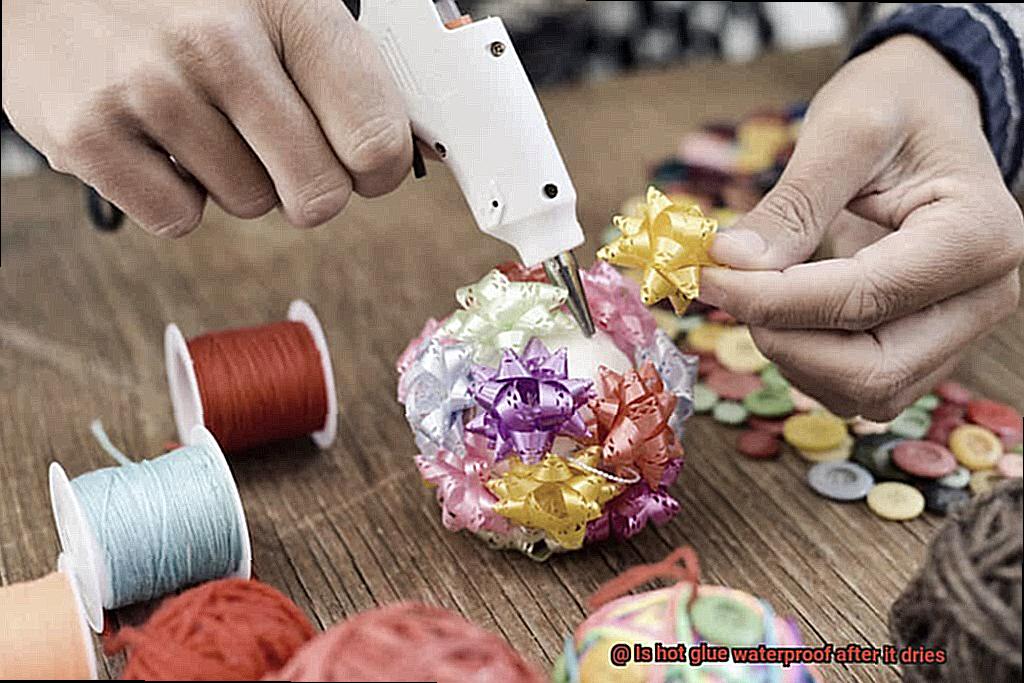
One crucial factor to consider when examining the water resistance of hot glue is the type of hot glue used. Hot glue comes in different types, such as low-temperature and high-temperature glue. Low-temperature glue is perfect for bonding delicate materials like paper and fabric, while high-temperature glue is ideal for heavy-duty materials like metal and plastic. High-temperature hot glue has better water resistance than its low-temperature counterpart since it sets harder and has a more robust bond.
Another critical factor that can affect the water resistance of hot glue is the surface it’s applied to. Hot glue adheres well to porous surfaces like wood and fabric, but it may not bond well with non-porous surfaces like glass or metal. When hot glue is applied to non-porous surfaces, it may not penetrate the surface well, resulting in poor adhesion and reduced water resistance.
Temperature and humidity are also crucial factors to consider when examining the water resistance of hot glue. Hot glue may melt or soften when exposed to high temperatures, causing it to lose its adhesive properties. Additionally, high humidity levels can cause hot glue to absorb moisture, resulting in reduced water resistance.
Finally, the application method can significantly affect the water resistance of hot glue. Applying hot glue evenly and in sufficient amounts can create a strong bond that can withstand exposure to water. However, if too little hot glue is applied or if it’s applied unevenly, it may not create a robust enough bond to resist exposure to water.
How to Determine if a Specific Hot Glue Is Waterproof
Hot glue is a versatile adhesive that is used for a variety of projects, but determining if it’s waterproof can be a challenge. Not all hot glue formulas are created equal and some may not hold up as well when exposed to moisture. In this blog post, we’ll dive into 5 essential steps to help you determine if your hot glue is waterproof.
Step 1: Check the Label or Product Description
The first step in determining if your hot glue is waterproof is to check the label or product description. Look for indications that the glue is water-resistant or waterproof. If this information isn’t readily available, do some additional research online or contact the manufacturer directly.
Step 2: Conduct an At-Home Experiment
To test the water-resistance of your hot glue, apply a small amount to a non-porous surface like glass or metal and let it dry completely. Then, submerge the glued area in water for a set period of time and observe any changes. If the glue remains firmly bonded to the surface and doesn’t break down or dissolve when exposed to water, it’s likely waterproof.
Step 3: Consider the Temperature
It’s important to consider the temperature of the water when testing your hot glue’s water resistance. Hotter temperatures may cause the glue to soften or melt, while colder temperatures may cause it to become brittle and lose its adhesive properties. Keep this in mind when conducting your at-home experiment.
Step 4: Evaluate The Surface
The surface you apply your hot glue to can also impact its water-resistance. Some materials may be more porous or absorbent than others, affecting the adhesive properties of the glue. For example, hot glue may not work as well on fabrics or other highly absorbent surfaces compared to non-porous materials like plastic or metal. Keep this in mind when evaluating your hot glue’s water resistance.
Step 5: Consult with Users or Experts
Lastly, consult with other users or experts in the field to determine if a specific hot glue is waterproof. Online forums and review websites can be a great resource for gathering information and feedback from others who have used a particular product.
High-Temperature vs Low-Temperature Hot Glue
Hot glue is a versatile adhesive that has become a favorite for various DIY projects, crafts, and home repairs. However, not all hot glues are created equal when it comes to waterproofing. There are two main types of hot glue: high-temperature and low-temperature.
High-temperature hot glue is ideal for bonding materials that require a strong and durable hold, such as wood, metal, and plastic. It melts at a higher temperature and forms a stronger bond with the material it is applied to, making it more effective at withstanding exposure to water and moisture than low-temperature hot glue. Nevertheless, not all high-temperature hot glues are waterproof. Some may contain additives or fillers that can weaken the bond over time or when exposed to water. Thus, it’s essential to look for products specifically formulated for outdoor or marine use if you need waterproofing.
In contrast, low-temperature hot glue is best suited for delicate materials that can be easily damaged by high heat, such as foam and fabric. While not as effective at waterproofing as high-temperature hot glue, it can still provide some level of protection against moisture. If you need to use low-temperature hot glue for a waterproofing project, applying multiple layers can help ensure a stronger hold.
Testing a Small Area before Using Hot Glue in Wet Conditions
When it comes to using hot glue in wet conditions, it’s important to ensure that the glue remains waterproof after drying. To achieve a strong and long-lasting bond, it’s crucial to test a small area first.
To test the glue, simply apply a small amount to the surface and let it dry completely. Once dry, place a few drops of water on the glue and observe if it beads up or absorbs into the glue.
If the water beads up and rolls off, then the glue is waterproof and suitable for use in wet conditions. However, if the water absorbs into the glue, it may not be suitable for use in wet conditions, and you should consider using an alternative adhesive.
There are several factors that can affect the waterproofing of hot glue, such as the type of surface being glued and the temperature and humidity of the environment. For instance, hot glue may not adhere well to certain materials like metal or plastic, or it may become less waterproof in high humidity environments. Therefore, it’s essential to test the glue on the specific surface and under the specific conditions before using it.
Using a waterproof hot glue specifically designed for wet conditions is highly recommended. These types of hot glues contain special additives that make them more resistant to water and moisture, ensuring a strong and long-lasting bond even in damp or wet environments. Make sure to follow the manufacturer’s instructions for use and application when using these types of hot glues.
In summary, testing a small area before using hot glue in wet conditions is an essential step to ensure that your project remains intact even in damp or wet environments. By following these tips and using a waterproof hot glue, you can achieve reliable and long-lasting results. So go ahead and start your project with confidence knowing that your project will withstand any weather conditions. Here are some additional tips to keep in mind:
UBIHBYJI6Wc” >
Also Read: Is Super Glue Waterproof? – Glue Things
Conclusion
In summary, hot glue is a dynamic adhesive that can be utilized for numerous applications such as DIY projects, crafts, and home repairs. However, determining whether hot glue is waterproof after it dries is not always clear-cut. The type of hot glue utilized, the surface being bonded, and the environment in which the item will be exposed all play a crucial role in its water resistance.
When using basic hot glue sticks, it’s important to note that they are not waterproof and may deteriorate when exposed to water or high humidity. Conversely, certain specialty hot glues are designed to be water-resistant or even waterproof. It’s critical to select the appropriate type of hot glue based on your project’s requirements to ensure a dependable and long-lasting bond.
In wet conditions, it’s imperative to test a small area first before applying hot glue to the entire surface. This will help determine if the glue remains waterproof after drying and ensure a robust bond even in damp or wet environments.
Ultimately, comprehending whether hot glue is waterproof is crucial because it impacts which projects you can undertake with confidence.

